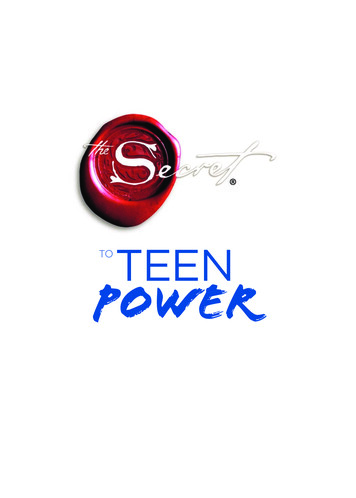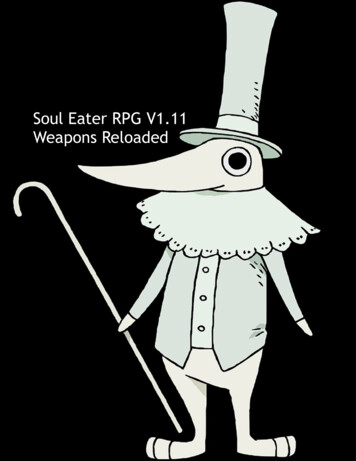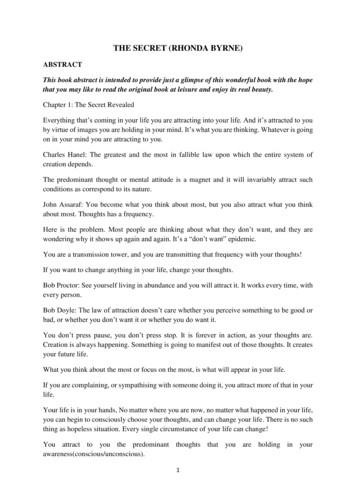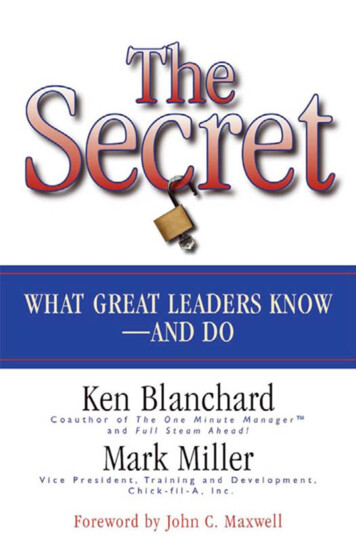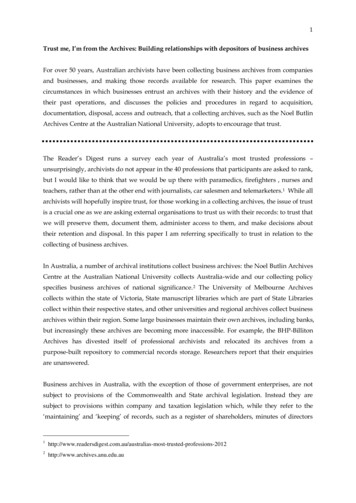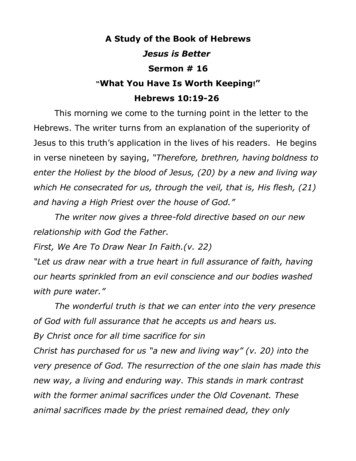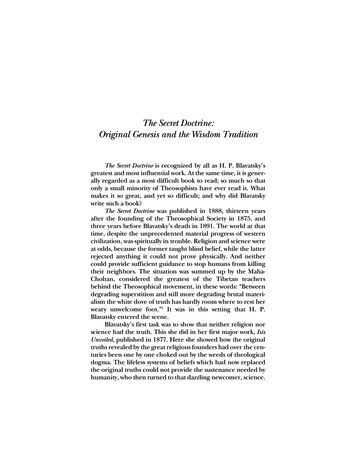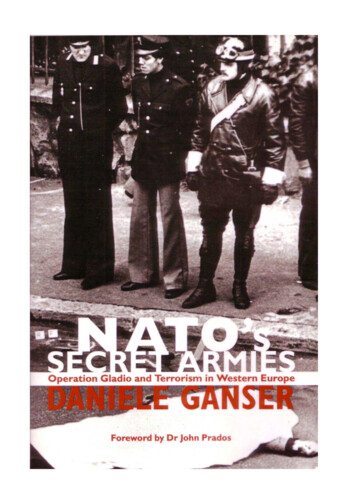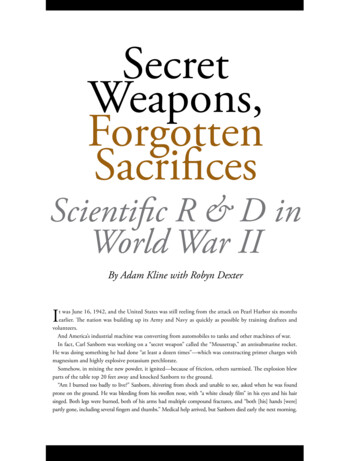
Transcription
SecretWeapons,ForgottenSacrificesScientific R & D inWorld War IIBy Adam Kline with Robyn DexterIt was June 16, 1942, and the United States was still reeling from the attack on Pearl Harbor six monthsearlier. The nation was building up its Army and Navy as quickly as possible by training draftees andvolunteers.And America’s industrial machine was converting from automobiles to tanks and other machines of war.In fact, Carl Sanborn was working on a “secret weapon” called the “Mousetrap,” an antisubmarine rocket.He was doing something he had done “at least a dozen times”—which was constructing primer charges withmagnesium and highly explosive potassium perchlorate.Somehow, in mixing the new powder, it ignited—because of friction, others surmised. The explosion blewparts of the table top 20 feet away and knocked Sanborn to the ground.“Am I burned too badly to live?” Sanborn, shivering from shock and unable to see, asked when he was foundprone on the ground. He was bleeding from his swollen nose, with “a white cloudy film” in his eyes and his hairsinged. Both legs were burned, both of his arms had multiple compound fractures, and “both [his] hands [were]partly gone, including several fingers and thumbs.” Medical help arrived, but Sanborn died early the next morning.
Just as OSRD projects were overshadowedSanborn became another casualty of war, named “Aunt Jemima”) to pyrotechnic “panicby reports from the front, the deaths of itsbut not on the battlefields of Europe or the creators.”personnel in pursuit of scientific research fellislands of the South Pacific.into obscurity, despite the enduring popularSanborn was an employee of Californiainterest in World War II.Institute of Technology working with the FDR Taps Vannevar BushThe OSRD traced its origins to the creationU.S. Office of Scientific Research and Devel To Oversee War Researchof the National Defense Research Commit opment (OSRD) near Pasadena to developthe antisubmarine rockets. Throughout theThe OSRD’s work, however, often met tee (NDRC) in June 1940. President FranklinD. Roosevelt appointed Vannevar Bush as itswar, the OSRD worked to find new weapon with tragedy.chairman.ry for America’s military toBush, president of thedefeat Hitler’s Third ReichCarnegie Institute andand the Empire of Japan.chairman of the Nation A wide variety of “inven al Advisory Commit tive” proposals passedtee for Aeronautics, hadacross the OSRD’s desksa distinguished career.as the war effort broughtHe had taught electricalfresh problems, whichengineering at Tufts Uni demanded creative solu tions. Some projects neverversity and Massachusettssaw the light of day, whileInstitute of Technology,others filled up the fileshelped create the Ray with myriad details of theirtheon Company, anddevelopment, testing, anddeveloped a machine thatcould solve differentialshipping to the field.equations. A prodigiousWhile historic break tinkerer, Bush even cre throughs such as theated a special bird feederatomic bomb and the“inhospitable to greedyinvention of penicil pigeons and blue jays.”lin were widely coveredproducts of U.S. scientificAfter the war, whenresearch during the war,President Harry S. Tru man told him he hadmany of the OSRD proj a politician’s instincts,ects, whether successfulor failures, remain largelyBush replied, “Mr.President, what the hellunknown.do you think I’ve beenThe Office of Strate doing around this towngic Services (OSS)—theprecursor of the Centralfor five or six years?”One of the out-of-the-ordinary products OSRD scientists were directed to create was anIntelligenceAgency—Under Bush, the NDRCedible plastic explosive, code-named “Aunt Jemima.” The mixture had to be undetectable,was to “conduct researchand the military servicessafe to transport, and able to be baked into normal bread, biscuits, or muffins.for the creation andturned to the OSRD andits director, Vannevar Bush, when theyBy the end of May 1943, the OSRD improvement of instrumentalities, meth needed new equipment, whether it was a acknowledged 10 fatalities “occurring in con ods and materials of warfare,” which it didsolution to malaria or a silenced pistol.nection with . . . OSRD work.” Other deaths with the help of scientists and engineersUnder Division 19 (Miscellaneous would follow. In the course of their duties to from U.S. companies and universities.Weapons), OSRD scientists brainstormed develop innovative weapons and gear, scientistsHowever, the NDRC was soon succeededeverything from edible plastic explosive (code- and workers perished in work-related accidents. by another body: the OSRD.Secret Weapons, Forgotten SacrificesPrologue 25
The frontispiece of an OSRD report on studyingunderwater ballistics illustrates the launching equip ment for projectiles and spheres.Because the NDRC was only researchfocused, it was necessary to create an agencythat would handle both the research anddevelopment of projects. In addition, anew organization could properly coordi nate research between military branches andmanage much-needed medical research.Accordingly, Executive Order 8807,issued June 28, 1941, by President Roos evelt, established the OSRD. Bush becameits director, and the OSRD would comprisethe NDRC—now with only the power to“advise and assist the Director”—alongwith the Advisory Council, Committee onMedical Research, Administrative Office,and Liaison Office. (Other divisions werelater added.)The OSRD also had the power to use gov ernment resources and to make contractswith individuals, companies, and other sci entific organizations. This new organizationprovided the impetus for critical scientificresearch during the war.“Evil Smelling Substances”Proposed as a WeaponThe most unconventional suggestionscould succeed in the OSRD. On November20, 1943, Stanley P. Lovell, director of OSS’sresearch and development, sent an unusualrequest in a letter to Division 19 head Har ris M. Chadwell. He wanted “to providecivilian populations with . . . a liquid . . .[that] will produce unmistakable evidence ofextreme personal uncleanliness.”Amid the serious letters and reports in OSRDrecords is a memorandum concerning confusionover an apparent request for “five pounds of livemonsters.” The puzzle was cleared up when some one realized that by correcting three letters, themonsters became “hamsters.”Spring 2016
Vannevar Bush headed the OSRD after PresidentRoosevelt created the office in 1941. Bush had previ ously served as chairman of the National DefenseResearch Committee.This memorandum inaugurated project“Who, Me?” (SAC-31), a joint venture withthe Arthur D. Little Company, a chemicaland engineering consulting company.Researchers mulled over formulas for their“evil smelling substances,” focusing on “strangeor novel” odors to alarm the targets, dispersecrowds, and contaminate enemy supplies.They considered using mercaptans, sulphides,methyl telluride, ammonium valerate, and thi aldine as ingredients.Eventually, the first “Who, Me?” formulawas developed in February 1944 to use againstthe Japanese. It consisted of n-Butyric acid,n-Valeric acid, n-Caproic acid, and Skatole;this particular batch had a “powerful and last ing” fecal odor.By late 1944, the team decided that sucha smell would be ineffective, so Dr. E. C.Crocker instead recommended a “skunky”mixture of alpha ionone, butyric acid andamyl mercaptan. After grappling with nag ging difficulties—fragile glass containersbreaking, accidental dripping onto users, andleaky tubes—the OSS finally shipped out 500tubes of each formula on February 27, 1945.Secret Weapons, Forgotten SacrificesThe Arthur D. Little Company worked with the OSRD to fill a request from the OSS.The OSS wanted a foulsmelling substance that could alarm a population or contaminate enemy supplies.The “Who, Me?” researchcame up with several stinkers before settling on a “skunky” mixture.Night Landings and SmokescreensProposed for Army and NavyOther ideas were less offbeat but equallyinnovative.In 1941, the NDRC considered develop ing “illuminated smoke clouds” for use “innight operations against attacking aircraft.”Shells, rockets, or airplanes placed the smoke screen, then flares would blind the maraud ers and silhouette them against the night sky,easy targets for anti-aircraft guns and fighters.Unfortunately, this method required tens ofthousands of shells and flares an hour. Sci entists estimated that 500 tons of smoke forevery 100 square miles were needed to create“a totally obscuring cloud of minimum thick ness.” The amount of equipment and materi als needed was deemed “prohibitively large”by Division A (Armor and Ordnance) ChairRichard C. Tolman, who recommended thatthe plan be dropped.When the Army Air Forces asked for a meansof landing aircraft while hiding the bases fromthe enemy, the NDRC created ultraviolet reflec tor beacons that would demarcate the runwayand aircraft-mounted UV lights that wouldpick them up, enabling a safe landing. In August1942, flight tests were successful. The markerswere viewed up to 4,000 feet “on a hazy night,”and the test plane was able to land.The Navy was interested in using the system onits aircraft carriers and received another demon stration. However, the Army Air Forces advisedagainst using the system, saying that “greatersecrecy in night operation” was not necessary.Prologue 27
The OSS’s Project Fantasia was an attempt at psychological warfare. OSRD scientists were asked to create a device that would simulate a fearsome creatureto terrify the Japanese.Still, they encouraged further investigation into,and testing of, an “invisible beacon” for landing.OCRD Told to Produce Device,“Simulating a Creature” for NightSome Division 19 projects, though, were tru ly absurd. The foremost among them was Proj ect Fantasia (SAC-26), which arose from a May21, 1943, OSS directive asking Chadwell for an“eerie,” luminescent balloon as a psychologicalweapon against the Japanese. Even though OSSofficial Lovell deemed it “questionable, [and]outre,” research began into the device.The OSS stipulated that Fantasia wouldneed to be visible from 2,000 feet and “obliter ated completely” after 15 minutes. Researchersat the drawing board postulated using radiumsalts, special paint, fireworks, UV devices, oreven “phosphorescent gas” to illuminate Fan 28 PrologueWhen two colonels asked about using methane to “freeze a neighborhood,” theexpert at Harvard Medical School pointed out the plan’s shortcomings.tasia and “instill fear, terror, and despair.” Hop ing to exploit perceived Japanese superstitions,the OSRD considered building the device inthe shape of “a harmful demon, evil eye or a‘hex,’” or perhaps a “grotesque animal” such asa fox or dragon. To incinerate the hydrogenfilled balloon, project members proposedusing a delayed incendiary.Still, doubts lingered.In a July 5 memorandum to Lovell, itwas clear that “We do not contemplatewidespread . . . use of the device,” and thatit might only be effective against Japanese“under extremely trying conditions.”Memorandums suggested using the device“over Chinese lines” or possibly deploying itagainst “isolated groups” of Japanese. (Thesewere considered vulnerable to panic.) Short ages of qualified personnel, high potentialcosts, and a general lack of enthusiasm final ly put an end to Fantasia.In response to a September 18 letter fromChadwell seeking an end to the project,Lovell complied. The failure of Fantasia “willserve as a critique to us in the field of purereason,” the latter wrote. The OSRD seemedhappy to dispose of Fantasia. The minutesfrom Division 19 on November 4 stated,“This problem of Fantasia has been merci fully completed,” and SAC-26 was relegatedto “Dead as Dodo” status by July 6, 1944.OSRD Rejects Some ProjectsFor Those “Of Great Importance”Similarly, a number of other OSRD initia tives were discarded on the grounds of theirimplausibility. When two colonels inquired in1944 about “using methane bombs to freeze aneighborhood,” Alan R. Moritz of Harvard’smedical school dismissed the proposition,Spring 2016
saying that such a weapon would only harmthose within “the immediate vicinity.” Healso mentioned that methane gas would causesevere injury. He stated that using incendiaryrounds to ignite a kilogram of methane gaswould release “approximately 13,000 kilocalories,” as opposed to the mere 250 kilocalories taken in by warming liquid methane.Another Division 19 research project, “Black out” (SAC-20), was more practical than Fanta sia. It sought to engineer explosive lightbulbs foruse in China, presumably against the Japaneseoccupiers. On May 17, 1943, a month afterChadwell received the order, Blackout ran intotrouble. George Kistiakowsky, head of Divi sion 8 (Explosives), wrote emphatically that “Itis absolutely impossible to put enough explosiveThe government received several proposals to take the“death ray” from science fiction to fact. FBI Director J.Edgar Hoover forwarded a paper on “tele-concentra tion of high power energy” to the OSRD, which deemedit “entirely without technical content or import.”Secret Weapons, Forgotten Sacrificesinto the base of a transparent light bulb to makethe result more harmful than the popping of acracker.” Fragmentation would be limited, hewrote, the device’s lethal range would be two orthree feet at best, and liquid explosives would benoticed in the clear bulb. Blackout experiencedthe same fate as Fantasia by July 6, 1944.The most colorful proposals of all camefrom those eager to market a “death ray” tothe government. From 1940 to 1943, nofewer than six separate inventors approachedthe NDRC and OSRD with their plans.Christian H. Kenneweg was the first. Heclaimed to have a device that could produce a“highly concentrated molecular vibration” anddestroy enemy aircraft “at or over experimen tally ascertained distances of several miles.” Hehad already sent a letter to British Prime Min ister Winston Churchill, without success.Undeterred, Kenneweg wrote another let ter to President Roosevelt days later, appeal ing to “The great humanitarian complex ofthe Chief Executive” and noting that “Theera of the large bombing plane will definitelypass” thanks to his invention.The government’s response was unenthu siastic.K. T. Compton of the NDRC was “notoptimistic about the possibilities of thisinvention,” noting that any blast energywould be “rapidly dissipated.” By year’s end,Antonio Longoria, George A. Finch, JohnC. Roberts, and Mike Cronis attempted tointerest the government in their creations.One official scoffed at Finch and Roberts,saying, “The technical description reads like‘Amazing Science Tales.’” Despite the scientists’claim to have killed five ducks in flight withtheir device, Tolman believed that they had sim-Doing research on and testing new weapons wasdangerous work. Roy Nelson Hurt was killed in anaccident at a chemical facility producing a protectivecompound against poison gas.Prologue 29
ply used strychnine-laced grain, a “favorite stuntof self-styled death ray inventors.”The OSRD soon tired of the “Death RayAtomic Energy Machines” and “Lethal RayProjectors.” After reading a 1943 report by one“Professor Kraus” on his supposed death ray,Bush personally rejected the proposal in a letterto J. Edgar Hoover, calling it “a rambling state ment with a liberal use of scientific terms whichmakes . . . unsupported claims.” Little came ofthe death rays.“A Very Secret andVery Important Matter”As the war took millions of lives at Saipanand Stalingrad, at Caen and Cassino, at Kas serine and Kursk, and at countless other bat tlefields across the globe, OSRD membersalso gave their lives in the line of duty.On June 8, 1942, while U-boats roamed theAtlantic Ocean in search of Allied cargo ships,the OSRD tested a new anti-submarine weap on—underwater flares—off of Manasquan,New Jersey. In order to shoot photographs, theNavy lent two blimps. On board airship G-1that night were C. R. Hoover, L. S. Moyer, andF. C. Gilbert, while airship L-2 carried A. B.Wyse and I. H. Tilles. Accompanying the sci entists were eight Navy servicemen.According to eyewitnesses on a Coast Guardboat, at 9 p.m. L-2 “passed over the bow” of thevessel, signaling with its blinker, but the crewbelow asked that they signal again “as none ofthe seamen aboard clearly read it.” As L-2 circledto repeat the signal, “the gondola of L-2 struckthe bag of G-1,” and both plummeted into thedark ocean. The boat picked up one survivorand fired off all its red flares to call for help.The two blimps, held afloat by air pockets,were being towed back to shore in the hopesof rescuing any survivors, but G-1 detachedalong the way. The crew decided that it wouldbe better to continue towing one blimp ratherthan risk losing both by trying to retrieve thesecond blimp. Another boat picked up theG-1, but it sank once more in water estimat 30 Prologueed to be 60 feet deep and was not recovered.Upon reaching shore, the bodies of Wyse andtwo crewmembers were found in L-2. Tilles’sbody was found in the water the next morning.Altogether, 12 men died, and one luckyensign had escaped. Each scientist left awidow. Wyse, the youngest at 32 years old,left behind two young sons; Hoover, the old est at 56 years old, had one son in medicalschool and another in the Army.Four days later, Bush composed identicalletters to each grieving widow.“No word that I can write can of course less en your grief,” he explained. “Not every manwho serves his country does so in uniform.”While unable to disclose the “very secret andvery important” flare project, Bush wrote thateach man “made a real contribution to the“Not every manwho serves hiscountry does soin uniform”work . . . he has given his life for his country. . . as though he had been in the front linetrenches.”However, the OSRD’s work was not donehere. Due to a bureaucratic loophole, thescientists “were in a unique and unfortunatesituation.” As they were affiliated with uni versities and paid by them, they did not fallunder the Employees’ Compensation Act. InMay 1943, Bush sent a drafted bill designedto correct that problem to the House Com mittee on Claims, and later urged the Presi dent to approve it.The bill, which designated Wyse, Hoover,Moyer, and Tilles as civil employees (Gilberthad insurance and was deemed “adequately pro vided for”), entitled their families to governmentcompensation and was signed by Roosevelt onMarch 24, 1944. Sadly, Bush’s sympathy letterswould be repeated many times to yet more sur vivors of fallen OSRD workers.Developing Protective GearRisky Business for StaffEven OSRD personnel working to developprotective equipment were at risk. In an effortto avert the horrors of the last war’s chemicalweapons, the Commercial Solvents Companywas given a contract to produce “a compoundto be used . . . as a protection against poisongas.” The resulting product, S-461 protec tive ointment, was produced in Terre Haute,Indiana, where 28-year-old laborer Roy Nel son Hurt worked in the drying facility.At 6:45 in the morning of September23, 1942, smoke billowed from the dryerbuilding’s south door, and Joseph Roman, afellow plant worker, dashed inside. With acloth around his nose and mouth to wardoff the thick, noxious smoke, he stumbledtoward Hurt and managed to help him outof the building, despite being “nearly over come by the fumes and by shock.” An ambu lance arrived within eight minutes, but adoctor caring for Hurt at the hospital foundhim “semi-conscious,” with “second andthird degree burns involving practically theentire body.” Even Hurt’s eyes had sufferedthird-degree burns and “practically completedestruction of the corneas.” Despite bloodplasma infusions and hot paraffin dressings,Hurt died at 7:30 p.m.An investigation soon determined the causeof the accident. “Inferior quality” S-461, unsta ble with impurities, had decomposed. Over ahalf-ton of the material had been destroyed.Mrs. Hurt received 2,000 from a companyinsurance plan, plus 5,000 more from Indi ana’s Workmen’s Compensation Act. HomerAdkins, who inspected the plant, added thathe hoped “that it may be possible for O.S.R.D.Spring 2016
to assist Mrs. Hurt financially,” but noted that“No mention of this possibility . . . has beenmade by anyone so far as I know.” On August14, 1946, Bush wrote to Mrs. Hurt to explainthe circumstances of her husband’s death.The fear of “horrible suffering and disfigure ment [by] poison gas” had driven the need forS-461, which had been shipped out to Gua dalcanal just days after Hurt’s death. Bush eventhanked Roman for his heroism, commend ing his “quick thinking and prompt action.”While the property damage to the plant wasdismissed by Adkins as “inconsequential,” thehuman cost was anything but trivial.“The Whole ThingHad Gone”The Budget and Finance Office’s “Acci dent” file mentions that one E. R. Barnard,an assistant project director at Standard Oil,was injured in a flamethrower accident, butgave few details. The full story is held in theStandard Oil contractor files. The company,which frequently worked on OSRD projects,was tasked on April 1, 1943, with creatinga tank-mounted flamethrower. Engineersdevised a tank-towed trailer containing jelliedgasoline fuel and compressed air. The pressurechamber was highly problematic and requiredmultiple repairs after leaks during tests.On May 29, 1944, the flamethrower wasdue for another test involving 13 workers,ranging from the project director to thedriver. As the compressors were brought upto a pressure of 500 psi, the right compressorfailed but was soon restarted. Its low-pres sure unloading valve remained open, but atap with an iron bar solved that problem.As research engineer W. A. Proell turnedAn internal memo to Vannevar Bush noted the risks—sometimes fatal—OSRD personnel faced.his back and walked away, he heard “somestrange noise,” but when he turned his head,“he realized that the whole thing had gone.”Another bystander saw a “sheet of flame onthe left side of the trailer,” then was hurledto the ground by “a violent shock wave” asthe pressure chamber exploded. Two othersremembered little more than that “everythingwas on fire.” The tank was “completely burnedout,” and the wreckage of the “badly disin tegrated” pressure vessel was strewn acrossover half a mile. Senior research engineer F.K. Ovitz, research engineer J. G. Nellis, andexperimental mechanics J. J. Hanusin and J.M. Leonard were all mortally wounded. Nineothers were injured, two of them seriously.Inquiries by Standard Oil, its subcontractorMerz Engineering, and the OSRD eventuallydetermined the cause of the catastrophic failure.The vessel was flawed from the start. AnalystsTo learn more about. . . Records relating to World War II research and development in the National Archives, go to /227.html. Records relating to World War II research and development at the Library of Congress, go to www.loc.gov/rr/scitech/trs/trsosrd.html. Records of the Office of Strategic Services in the National Archives, go to www.archives.gov/research/military/ww2/oss/.Secret Weapons, Forgotten SacrificesPrologue 31
During testing of a flamethrower towed by a tank, four personnel were mortallywounded when the poorly designed and fabricated vessel catastrophically failed.complained that it did not abide by indus try standards, was poorly welded, and had anunsound design. Weakened springs and lubri cating oil deposits had caused the right com pressor’s troublesome valve to stick open; as aresult, recompression and high temperaturesignited carbon or oil deposits. Fuel leaking intothe compressor was set ablaze, then “forcedback into the fuel chamber, thereby igniting theentire supply of fuel.” An OSRD memorandumregarded the disaster as “just one of those unfor tunate mishaps which may occur in the courseof any research on dangerous instrumentalitiesof war performed at an accelerated pace.” (In abit of twisted irony, the earlier “Firefly” projectassigned to Standard Oil was a device designedto detonate gas tanks.) It was concluded that“direct connection of an air compressor to thefuel container is extremely hazardous.” A faultyvalve and shoddy engineering had cost the livesof four men.Mixing of ChemicalsCan Produce ExplosionOther grave accidents merited attentionin the OSRD files. On April 3, 1943, anexplosion at Servel, Inc., which produced oilsmoke pots for the OSRD, “destroyed thelaboratory,” fatally injuring technical aideClarence O’Bryan. He suffered serious burns32 Prologueand critical injuries tohis legs and lower body.He died three days laterin the hospital fromkidney failure. O’Bryanhad been married forless than a month. Thecause of the blast wasunknown, but it wasspeculated to have beenthe spontaneous com bustion of the chloratedsawdust and charcoal inthe dryers.When the OSRD con ceived a device capableof “extracting oxy gen from the air” andrecycling it, they con- The widow of Frank Ovitz, one of those killed in the flamethrower explosion,wrote to Vannevar Bush expressing the hope that her husband’s research worktracted the Univer would eventually save other lives.sity of Pennsylvania todevelop it. Scientists working on the project,which was deemed “of great importance to bill for Geissman in a July 29, 1947, mem the war effort,” used salcomine, a “cobalt orandum to the Bureau of the Budget. (Acontaining organic chelate,” to absorb and scribbled annotation confirmed the bill wasrelease oxygen. On April 18, 1944, the pres approved.)Under another OSRD contract, Sam surized experimental device sprang a leak,spraying salcomine into the air. Theodore uel Ruben, “the best young experimentalA. Geissman stopped the leak but suffered chemist in the country,” in one colleague’s“severe toxic hepatitis” in the process, which eyes, worked at the University of Califor required expensive medical treatment. Years nia, Berkeley. In late September 1943, anlater, the OSRD urged passage of a relief experimental vial of phosgene shattered,Spring 2016
spraying the contents into his face. He wasrushed to an oxygen tent, but his conditiondeteriorated. He died the next day, leaving“a wife and three small children.” Since hehad previously been involved in ordinaryresearch on non-toxic butane gas, he didnot have extra-hazardous insurance. Theselamentable cases and others like themwould stay out of the limelight, effectivelyforgotten.In the OSRD, sacrifices were made andconspicuous heroism was displayed, fromJoseph Roman’s attempt to save his col league to Geissman’s stopping the toxicsalcomine leak with disregard for his ownsafety. In October 1942, in the wake of thefatal blimp crash, Commercial Solventsfire, and Caltech deaths, OSRD ExecutiveAssistant Carroll L. Wilson acknowledgedthat “Many of our personnel . . . exposethemselves to serious risks . . . our peopleare working with poisonous chemicals,with high explosives . . . with infectiousdiseases . . . Our men have not hesitated totake these risks.”One notable death was that of WallaceB. Caufield, Jr., an employee of Harvard’sRadio Research Laboratory, who was strafedby Luftwaffe aircraft in Luxembourg onJanuary 1, 1945, as the Battle of the Bulgeraged. As shown by its drafted relief bills andlobbying, the OSRD was reluctant to leavethe families of its fallen employees in desper ate financial straits and worked to compen sate them.The story of the OSRD, encompassingboth its unconventional projects and thelosses it suffered, is a potent reminder of therisks and rewards of scientific research dur ing World War II.Carl Sanborn’s death in June 1942 wasnot the first civilian victim claimed by thewar at sea. Caltech had already suffered adeath in connection to Mousetrap on March27, when assistant mechanic Raymond L.Robey was fatally burned.In a letter to Caltech, Bush conceded that“It is an exceedingly difficult thing to strike aSecret Weapons, Forgotten Sacrificesproper balance between . . . security of per sonnel on the one hand and . . . an importantand dangerous undertaking on the other.”The final chapter of the Sanborn tragedycame on January 6, 1948, when Congresspassed a law to relieve his dependents, withBush lobbying for recognition of Sanborn’s“supreme patriotism.”While he emphasized the need for vigilanceand safety precautions, he added: “It is neverpossible to be absolutely perfect. . . . If wewere to strive for absolute perfection, we sim ply could not . . . work at the speed which thewar effort warrants.” Bush pointed out that“If we can make speed we will save lives . . .[and] we will increase the safety of this coun try in a critical period of the anti-submarineeffort.”Relatively little public interest in the U.S.experience in World War II has focusedon the efforts on the home front to supplytroops with war-winning equipment, andeven less attention is devoted to the OSRD’swork. While its inventions were not alwaysaccepted, any research organization makesmissteps. The endless ingenuity of its sci entists demonstrated the extent of humancreativity. PNote on SourcesA special thank you to Elizabeth Fortson of Spe cial Media for her quick thoughts and able assis tance in acquiring some of the images used.Little has been written about the Office of Sci entific Research and Development in World WarII. In the 21st-century definition of “informa tion accessibility” determined by the number ofGoogle hits, the OSRD rates 18,000 hits. Manyof these hits repeat short biographical informa tion, giving dates, creation process, and seniorleadership. Little has been written about breadthof the projects; most of the focus on the Man hattan Project, and even less about the men andwomen who staffed them. In 1948, Irvin Stew art wrote a 358-page administrative history thatgives an excellent view into the office structure,the administrative evolution, and notes in no lessthan five places that they were heavily encour aged to hire women. The Library of Congressalso holds a significant amount of OSRD’s docu mentation, making research documentation, finalresult
Secret Weapons, Forgotten Sacriices . One of the out-of-the-ordinary products OSRD scientists were directed to create was an edible plastic explosive, code-named "Aunt Jemima." The mixture had to be undetectable, safe to transport, and able to be baked into normal bread, biscuits, or mufins. named "Aunt Jemima") to pyrotechnic "panic
